Craft Your Perfect DIY Welcome Sign: A Comprehensive Guide to Personalized Home Decor
Welcome to the captivating world of do-it-yourself (DIY) welcome signs! If you’re eager to infuse your home’s entrance with personality, warmth, and a unique touch that genuinely reflects your style, then embarking on a custom welcome sign project is an incredibly rewarding journey. Far more than just a decorative piece, a handmade welcome sign offers a heartfelt greeting to every guest, setting a friendly and inviting tone even before they step inside.
Creating your own custom welcome sign presents numerous advantages. Not only does it allow you to express your individual aesthetic and creativity, but it also provides a cost-effective alternative to often expensive store-bought options. Beyond the savings, there’s immense satisfaction in crafting something beautiful and meaningful with your own hands – a tangible representation of your care and hospitality. Whether you’re a seasoned DIY enthusiast looking for your next creative challenge or a beginner eager to tackle an accessible yet impactful home improvement project, this extensive guide is designed to empower you.
We will walk you through every stage of designing and crafting your perfect welcome sign, ensuring you have all the knowledge and confidence required. From selecting the ideal materials and gathering essential tools to mastering various crafting techniques and adding those all-important personal flourishes, you’ll discover everything needed to produce a one-of-a-kind sign. This bespoke creation will not only enhance your home’s curb appeal but also make a memorable and lasting impression on everyone who visits.
Understanding Different Welcome Sign Styles for Your Home
Before you dive into the crafting process, it’s beneficial to explore the diverse range of welcome sign styles available. Each style offers a distinct aesthetic and functionality, allowing you to choose one that best complements your home’s architecture and your personal taste. Consider where you plan to place your sign and the overall message you wish to convey.
- Vertical Porch Signs: These tall, narrow signs are incredibly popular for their striking presence. Typically placed alongside your front door, on a porch, or even in an entryway, they naturally draw the eye upwards. Vertical signs offer ample space for a longer, more elaborate welcome message, family name, or decorative elements like seasonal motifs and charming illustrations. Their height makes them visible from a distance, adding significant curb appeal.
- Horizontal Door Signs: Designed to be hung directly on your front door, these signs greet guests at eye level, offering a more intimate welcome. They are perfect for shorter, concise messages, a family monogram, or designs that fit well within a wide, rectangular format. Horizontal signs can be integrated beautifully with wreaths or other door decorations, providing a balanced and welcoming focal point.
- Round Signs: Circular signs introduce a whimsical and contemporary touch to your entrance. Their unique shape makes them an attractive alternative to traditional rectangular signs. They are particularly well-suited for showcasing a single initial, a family name surrounded by a wreath design, or a brief, heartfelt phrase. Round signs can be a lovely choice for a modern farmhouse or cottage-style home.
- Interchangeable and Reversible Signs: For those who love to refresh their decor with the changing seasons or holidays, interchangeable and reversible signs are a game-changer. These versatile signs often feature a main base panel to which various elements can be attached or a design that can be flipped to reveal a different message. This allows you to easily switch up your greeting for spring, summer, fall, winter, or special occasions like Christmas, Halloween, or Thanksgiving, keeping your entrance decor dynamic and engaging.
Creating a Cohesive and Personalized Design Concept
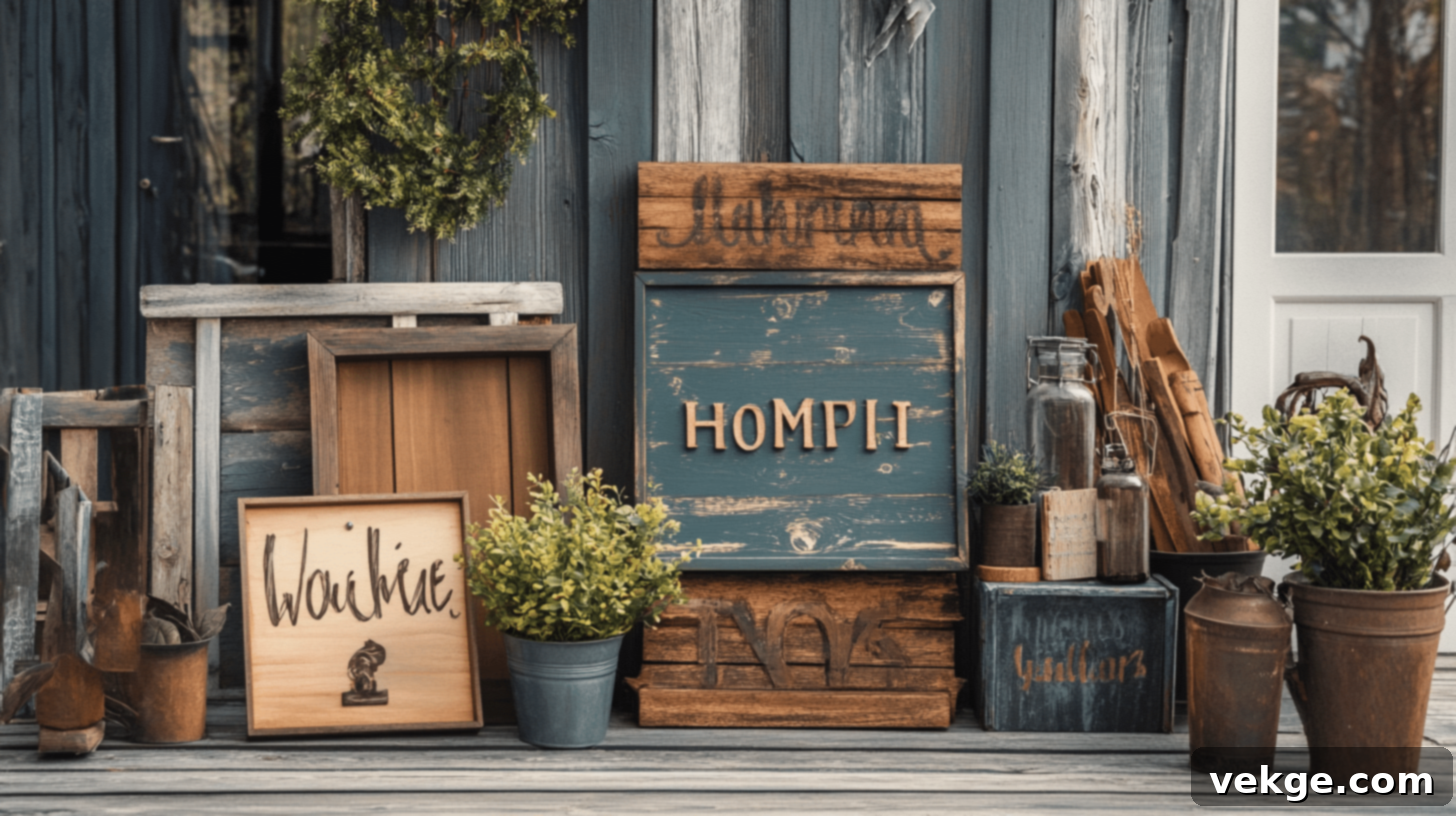
Once you’ve settled on a general sign style, the exciting process of developing your unique design concept begins. This is where your creativity truly shines, allowing you to craft a sign that feels authentically “you.” Thoughtful consideration of these factors will ensure your welcome sign is both beautiful and meaningful.
- Selecting a Theme that Complements Your Home: The overall aesthetic of your welcome sign should ideally harmonize with your home’s existing style and the surrounding environment. Explore popular themes such as rustic farmhouse, sleek modern, charming beachy, whimsical cottage, or timeless traditional. A consistent theme creates a cohesive and inviting look for your entire home exterior. Gather inspiration from Pinterest, home decor magazines, or even your favorite local shops.
- Choosing Fonts and Graphics for Visual Impact: Typography plays a crucial role in readability and conveying your sign’s character. Select fonts that are not only aesthetically pleasing but also easy to read from a distance. Consider combining different font styles – perhaps a bold script for a family name and a simpler sans-serif for a date or secondary message – to create visual interest and hierarchy. Incorporate complementary graphics such as elegant flourishes, directional arrows, seasonal icons (like leaves or snowflakes), or decorative borders to enhance your design and add charm.
- Incorporating Family Names, Initials, or Favorite Quotes: Personalization is at the heart of a DIY welcome sign. Make your sign truly unique by featuring your family name, individual initials, a significant date (such as a wedding anniversary or the year your home was established), or a meaningful quote that resonates with your household. This personal touch not only makes the sign special but also creates a deeper connection to your home and hospitality.
Choosing the Right Materials and Essential Tools for Your Project

With your design concept firmly in mind, the next crucial step is to select the appropriate materials and gather all the necessary tools. The right choices here will significantly impact the look, durability, and ease of crafting your welcome sign.
Selecting the Right Materials for Longevity and Aesthetics
The primary material for your sign will largely depend on your design preferences, budget, and, critically, whether the sign will be displayed indoors or outdoors. Each material offers distinct advantages and visual characteristics.
- Types of Wood: The Most Popular Choice: Wood remains a top choice for welcome signs due to its versatility and natural charm.
- Pine: An affordable and readily available option, pine is easy to cut, sand, and paint, making it excellent for beginners. It’s best suited for indoor signs or outdoor signs that will be very well protected, as it’s not naturally weather-resistant.
- Cedar: Known for its natural resistance to rot, decay, and insect damage, cedar is an excellent choice for outdoor welcome signs. It has a beautiful grain that can be stained or left natural for a rustic appeal. While slightly more expensive than pine, its durability makes it a worthwhile investment for outdoor exposure.
- Reclaimed Wood: For a unique, rustic, or vintage aesthetic, reclaimed wood (such as old fence boards, pallet wood, or barn wood) offers unparalleled character. Each piece tells a story with its natural imperfections, knots, and weathered finish. While it requires more preparation (cleaning, sanding, checking for nails), the result is a truly one-of-a-kind sign.
- Benefits of Each Wood Type for Indoor/Outdoor Use: It’s vital to match your wood choice with its intended display environment. Untreated pine and other softwoods are generally best reserved for indoor signs where they won’t be exposed to moisture or direct sunlight. For outdoor applications, cedar, redwood, or pressure-treated pine are superior choices due to their enhanced resistance to the elements. Remember that even weather-resistant woods will benefit greatly from proper sealing.
- Alternative Materials Beyond Wood: Don’t limit your creativity to wood! Consider other materials for different aesthetics and practical benefits:
- Metal (Aluminum or Steel): Offers a sleek, modern, or industrial look. Metal signs are highly durable and weather-resistant, often requiring less maintenance. They can be painted, etched, or have vinyl decals applied.
- Acrylic (Plexiglass): Provides a contemporary, glossy finish. Acrylic is lightweight, shatter-resistant, and comes in various colors. It’s excellent for a modern design and can be painted on, etched, or used as a backing for vinyl lettering.
- Chalkboard: A highly versatile option that allows you to change your welcome message as often as you like. You can buy pre-made chalkboard signs or apply chalkboard paint to a wood base. Perfect for a dynamic and interactive welcome.
Gathering Essential Tools and Supplies for a Smooth Project
Having all your tools and supplies ready before you begin will make the crafting process much smoother and more enjoyable. Here’s what you’ll typically need:
- Basic Woodworking Tools:
- Measuring Tape or Ruler: For accurate dimensions.
- Saw: A hand saw is suitable for small projects, while a jigsaw or circular saw offers more precision and speed for larger cuts.
- Sandpaper: Essential for a smooth finish. Have various grits on hand (e.g., 80-grit for rough shaping, 120-grit for general smoothing, 220-grit for a fine finish).
- Drill: Necessary if you plan to attach hanging hardware or embellishments that require screws.
- Painting Supplies:
- Brushes: A selection of sizes – larger brushes (2-3 inches) for applying background coats and smaller, angled brushes (1/2 inch to 1 inch) for detailed lettering and touch-ups.
- Foam Rollers: Ideal for achieving ultra-smooth, streak-free background paint applications on larger surfaces.
- Sponges: Useful for distressing effects, stippling, or applying a wash.
- Paint: Acrylic craft paint is versatile, water-based, and comes in a huge array of colors. For outdoor signs, ensure you use exterior-grade paint that is weather-resistant.
- Lettering Options: How you apply your text is a key design decision:
- Stencils: Reusable plastic or adhesive vinyl stencils are excellent for achieving clean, consistent lettering. They come in various fonts and sizes.
- Transfer Paper: Graphite or carbon transfer paper allows you to trace printed designs or text onto your wood surface, providing a guide for freehand painting.
- Freehand Painting: If you’re confident in your artistic skills, a pencil sketch as a guide, followed by careful freehand painting, offers the most organic and custom look.
- Vinyl Decals: Pre-cut adhesive vinyl letters are a quick and easy option, especially if you have access to a vinyl cutting machine (like a Cricut or Silhouette).
- Other Essentials: Painter’s tape, tack cloth (for removing sanding dust), wood filler (if using reclaimed wood), and a clear sealant.
Step-by-Step Guide to Crafting Your Personalized DIY Welcome Sign
With your design concept finalized and all your materials and tools at the ready, it’s time to bring your vision to life! Follow these detailed step-by-step instructions to craft a beautiful and durable welcome sign.
Step 1: Preparing the Wood Base for Your Masterpiece
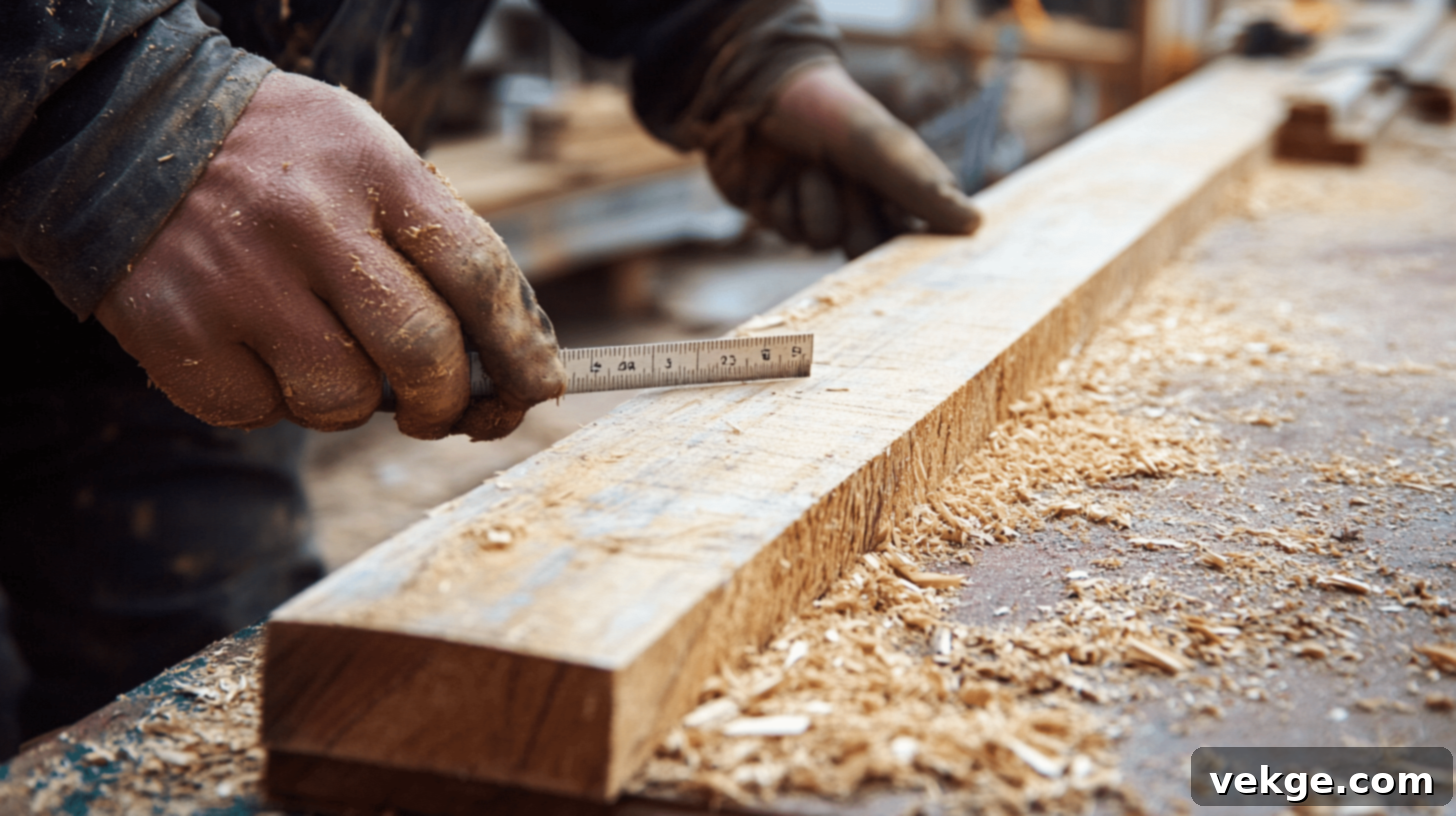
A well-prepared base is the foundation for a professional-looking sign. Don’t rush this crucial initial stage.
- Measuring and Cutting the Wood to Size: Carefully measure your chosen wood piece according to your desired sign dimensions. Use a ruler or measuring tape and mark your cut lines clearly with a pencil. Double-check all measurements before making any cuts to prevent errors. Use your chosen saw (hand, jigsaw, or circular) to make precise cuts. If you’re uncomfortable with sawing, many hardware stores offer cutting services.
- Sanding the Surface for a Flawless Finish: Begin sanding with a medium-grit sandpaper (e.g., 80-120 grit) to remove any rough spots, splinters, saw marks, or significant imperfections from the wood surface and edges. Once the initial roughness is gone, switch to a finer-grit sandpaper (e.g., 180-220 grit) to achieve a smooth, even surface. This fine sanding is crucial for paint adhesion and a professional finish. After sanding, use a tack cloth or a slightly damp cloth to wipe away all dust particles.
- Tips for Dealing with Reclaimed or Pallet Wood: Reclaimed wood often requires extra attention. Thoroughly inspect it for any embedded nails, screws, staples, or other hardware and carefully remove them. Fill any larger cracks, holes, or deep gouges with wood filler, allow it to dry completely according to the manufacturer’s instructions, then sand the filled areas smooth and flush with the surrounding wood. Pallet wood, in particular, may have uneven surfaces or deep grooves, requiring more extensive sanding to create a workable base.
Step 2: Applying the Background Finish – Setting the Mood
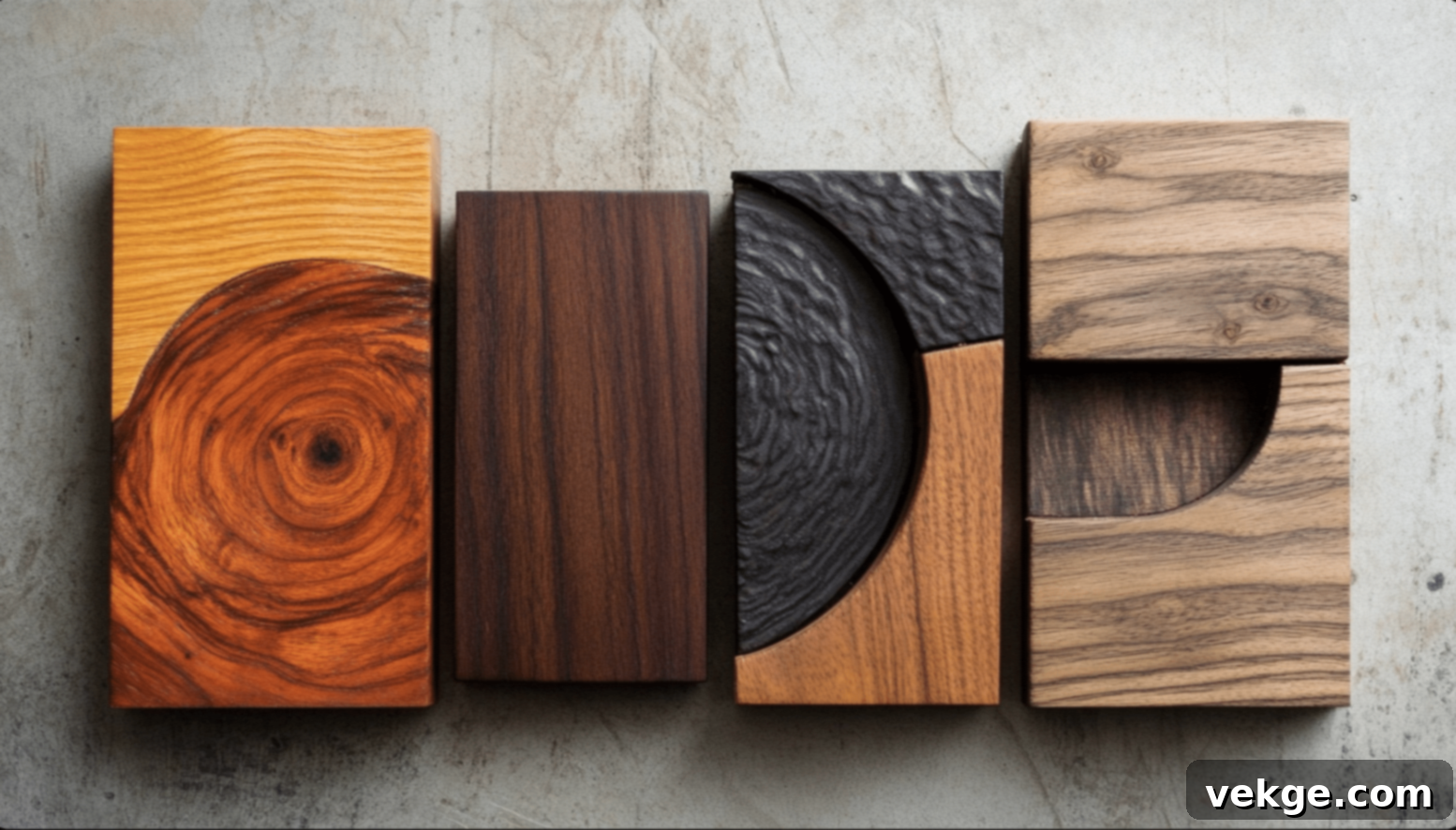
The background finish sets the tone for your entire sign, impacting its overall style and visual appeal.
- Choosing Between Paint, Stain, or Natural Wood: Your design concept will guide this decision.
- Paint: Provides a solid, opaque color that can match any decor. Use acrylic craft paint for versatility, or exterior-grade latex paint for outdoor signs.
- Stain: Enhances the wood’s natural grain and texture, offering a more rustic or classic look. Stains come in various wood tones and can be applied thinly or in multiple coats for deeper color.
- Natural Wood: For a truly organic, minimalist, or very rustic appeal, you can opt to leave the wood natural, perhaps just sealing it to protect its raw beauty.
- Techniques for Distressing or Whitewashing:
- Distressing: To achieve a vintage or weathered look, apply your base coat of paint, let it dry, then lightly sand the edges, corners, and certain flat areas with fine-grit sandpaper. This exposes hints of the natural wood or a previous paint layer underneath, creating an aged effect.
- Whitewashing: For a soft, translucent finish that allows the wood grain to show through, mix equal parts white paint and water (or use a dedicated whitewash product). Brush this diluted mixture onto the wood, then immediately wipe off the excess with a clean cloth. Repeat for more opacity if desired.
- Drying Times and Best Practices: Always allow each coat of paint or stain to dry completely before applying the next, or before moving on to the next step. Rushing this can lead to smudging, peeling, or uneven finishes. Work in a well-ventilated area to ensure proper drying and for your own safety. Always follow the manufacturer’s instructions for specific drying times, recoat windows, and cleanup procedures for your chosen product.
Step 3: Adding Lettering and Designs – The Heart of Your Message
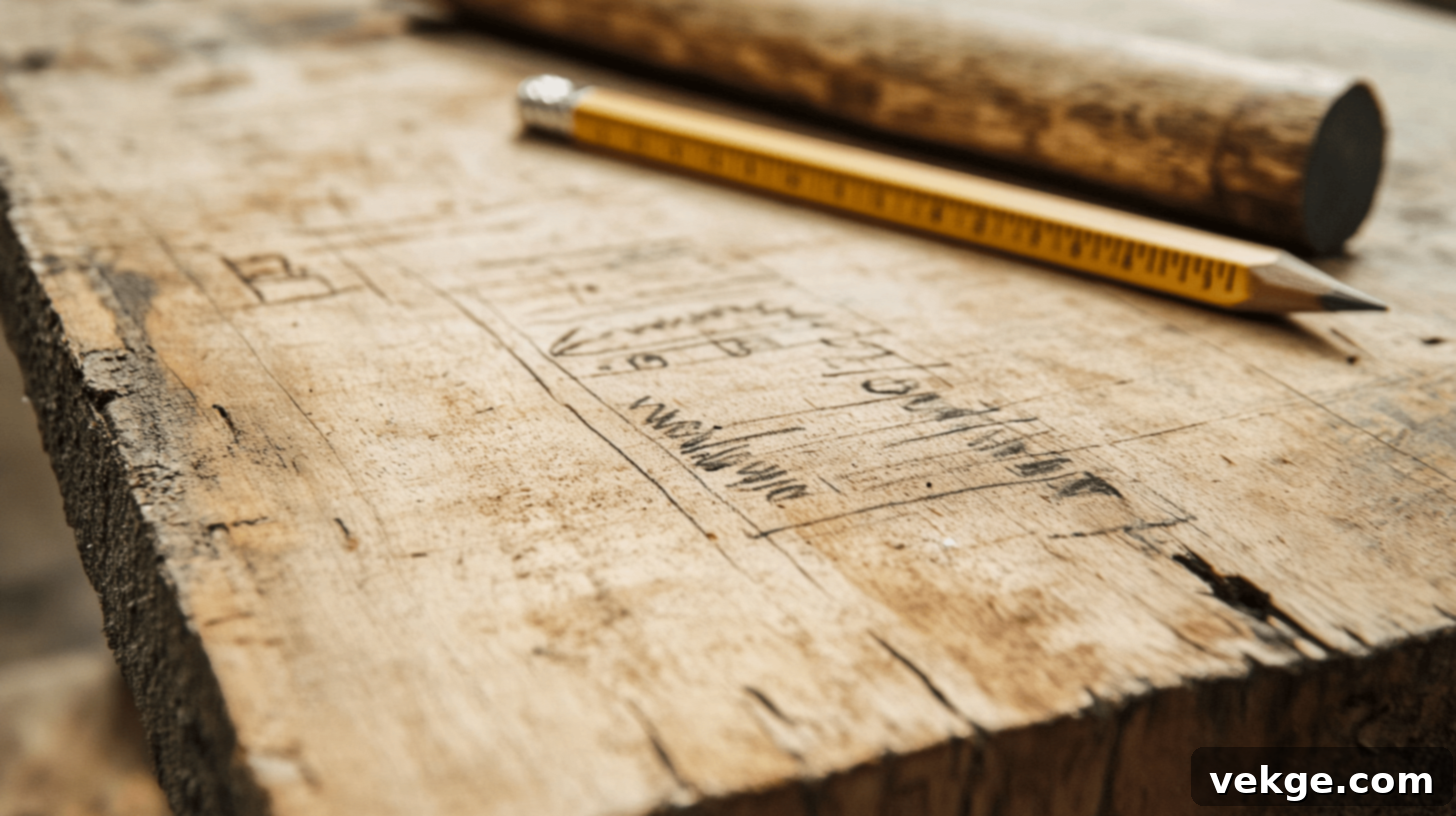
This is where your sign truly comes to life with your chosen message and imagery. Precision and patience are key here.
- Positioning Your Design on the Sign: Before applying any paint or vinyl, carefully lay out your design. Use a ruler, level, and a light pencil to mark the precise placement of your lettering, graphics, or any decorative elements. Ensure the spacing is even and the text is centered or aligned exactly as you envision. Take a step back to view the layout from a distance before committing.
- Methods for Transferring Images or Text:
- Using Stencils: Secure your stencil firmly in place with painter’s tape to prevent shifting and bleeding. Using a small sponge or a dedicated stencil brush, dab paint onto the stencil openings. Use very little paint on your brush/sponge to prevent it from seeping under the stencil. Apply multiple thin coats rather than one thick one.
- Using Transfer Paper: Print your design or text to the desired size. Place the transfer paper graphite-side down on your sign, then lay your printed design on top. Trace over the outlines of your design with a pencil, applying firm but even pressure. This will transfer a light guide onto your wood, which you can then paint over.
- Freehand Painting: If you’re confident in your brush skills, lightly sketch your design or lettering onto the prepared background with a pencil. Once you’re satisfied with the sketch, carefully paint over it using a small, fine-tipped brush.
- Vinyl Decals: If using pre-cut vinyl, carefully apply it according to the manufacturer’s instructions. Use a squeegee to smooth out any air bubbles and ensure firm adhesion.
- Painting Tips for Crisp Lines and Edges: For painted lettering, use a small, angled brush (often called a detail brush or liner brush). Dip the tip of your brush into the paint, then gently wipe off any excess on a paper towel or the rim of your paint container. This prevents blobs and allows for better control. Take your time, steady your hand (resting your wrist on the sign or a support can help), and apply thin, even strokes. If you make a small mistake, let the paint dry, then carefully touch it up with your background color using a very fine brush.
Step 4: Decorating and Embellishing – Adding Personal Flair
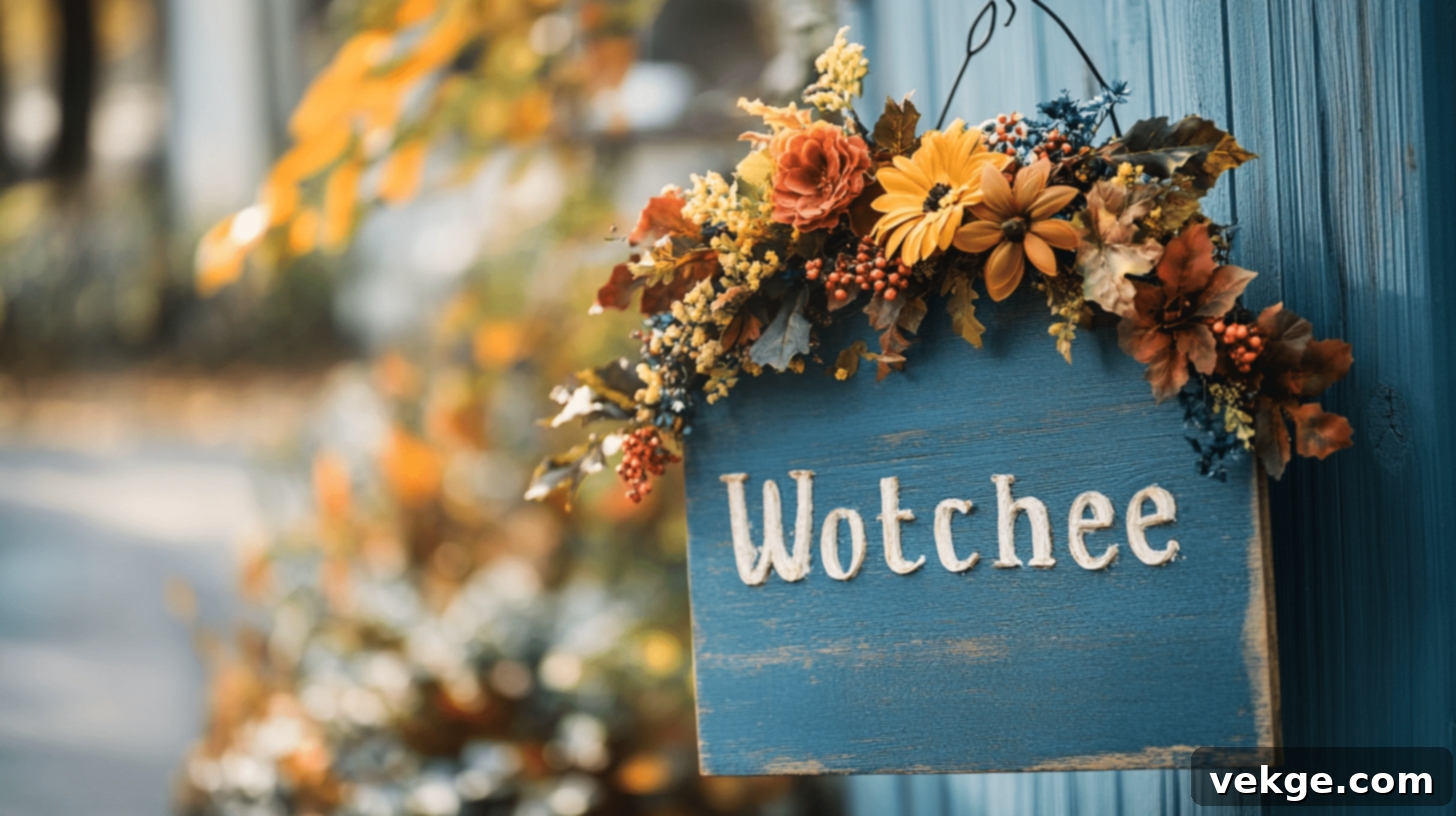
Now that your core design is complete, it’s time to add those decorative elements that truly personalize your sign and make it pop.
- Adding Floral Arrangements, Ribbons, or Other Accents: Once all paint and lettering are completely dry, you can attach various decorative elements. Artificial flowers, silk foliage, burlap bows, decorative ribbons, small craft figures, or even miniature wooden cutouts can add charm. Secure these elements firmly using a hot glue gun for immediate adhesion or a strong craft adhesive for a more permanent bond. Consider placement carefully to ensure they enhance, rather than overwhelm, your message.
- Ideas for Seasonal Decorations: Take advantage of your sign’s versatility by planning for seasonal accents. For fall, think about miniature pumpkins, faux autumn leaves, or plaid ribbons. For winter, incorporate holly berries, pinecones, or sparkly snowflakes. Spring might call for pastel flowers and greenery, while summer can feature bright sunflowers or nautical ropes. These seasonal touches keep your sign fresh and festive throughout the year.
- Making Interchangeable Pieces with Hooks or Velcro: To truly maximize the versatility of your sign, design decorative pieces that can be easily swapped out. Attach small D-rings or picture hooks to the back of your seasonal elements. Then, install corresponding small eye hooks or adhesive-backed Velcro strips onto your main welcome sign where you want to place the embellishments. This simple system allows you to effortlessly switch out elements for different holidays or seasons, giving you a dynamic and ever-changing welcome display.
Step 5: Sealing and Protecting Your Sign for Lasting Beauty
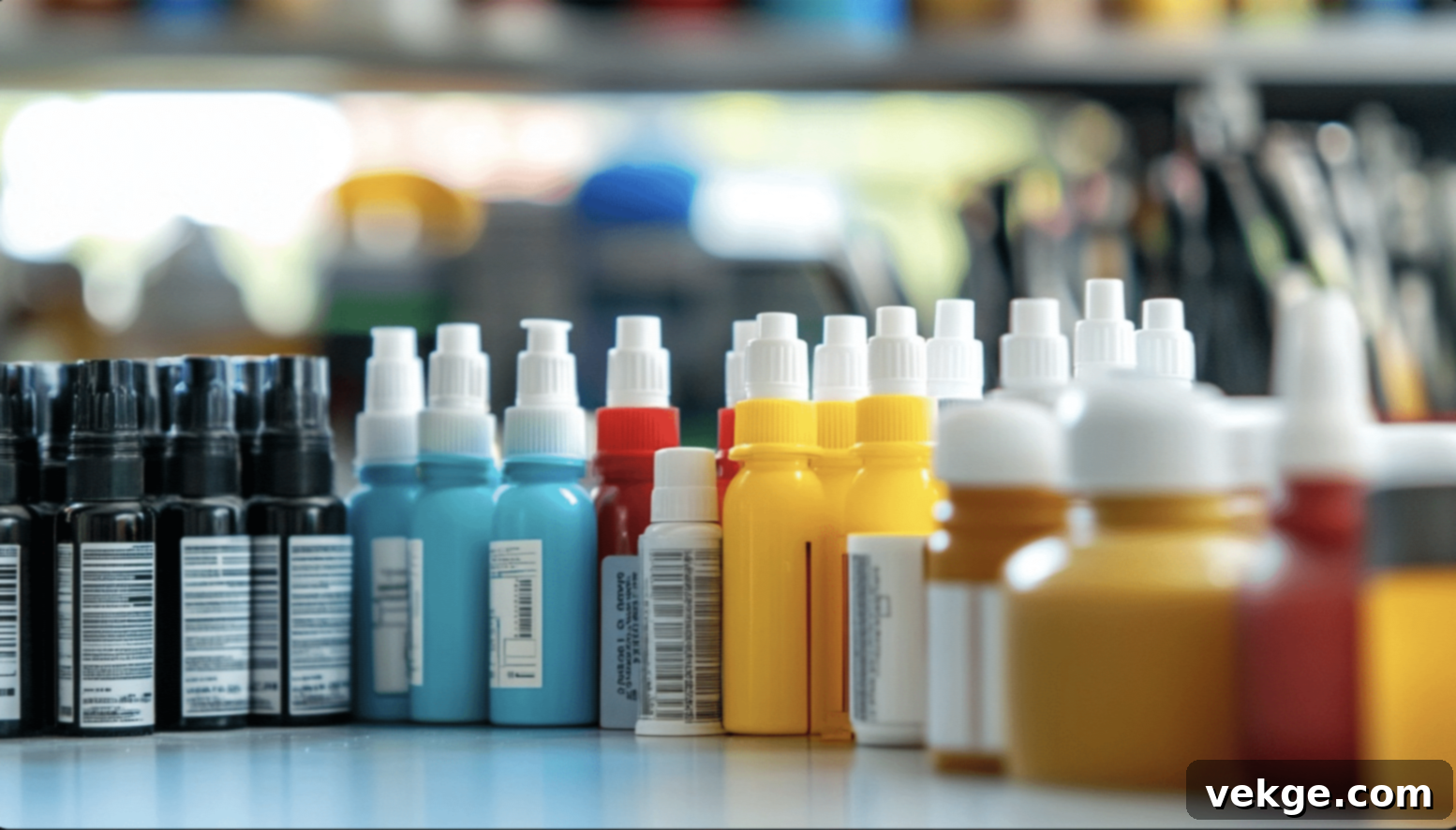
The final, crucial step is to protect your beautiful creation from the elements and wear, ensuring it remains vibrant for years to come.
- Selecting the Right Sealant for Indoor or Outdoor Use: Your sign’s intended location dictates the type of sealant you should use.
- For Outdoor Signs: Choose a durable, weatherproof, and UV-resistant sealant. Exterior polyurethane, spar varnish, or a marine-grade sealant are excellent choices, as they are designed to withstand moisture, temperature fluctuations, and sunlight. Look for products specifically labeled for outdoor use on wood.
- For Indoor Signs: A regular polyurethane (water-based or oil-based) or polycrylic sealant will provide sufficient protection against dust, light scratches, and general wear. These generally dry clear and are less prone to yellowing than some oil-based outdoor sealants.
- Application Techniques to Ensure Longevity: Apply the sealant in thin, even coats using a good quality brush or a spray can (following spray can instructions carefully for even coverage). Avoid applying thick layers, as this can lead to drips, bubbles, and a cloudy finish. Lightly sand between coats with a very fine-grit sandpaper (e.g., 400 grit) to achieve an ultra-smooth finish, wiping away dust with a tack cloth before the next coat. Follow the manufacturer’s instructions for drying times between coats and the recommended number of coats (typically 2-3 for indoor, 3-5 for outdoor).
- UV Protection Considerations: If your sign will be exposed to direct sunlight for extended periods, it’s highly recommended to choose a sealant with added UV inhibitors. UV rays can cause paint and wood to fade and discolor over time, and a good UV-resistant sealant will significantly slow down this process, keeping your sign looking vibrant longer.
Video Tutorial
For more details and visual guidance on crafting your perfect welcome sign, we highly recommend watching this detailed video tutorial by Laci Jane DIY. It offers practical demonstrations and additional tips that complement this guide.
Customization and Personalization: Making Your Sign Truly Yours
One of the most satisfying aspects of creating a DIY welcome sign is the boundless opportunity for customization. Your sign isn’t just a decoration; it’s a reflection of your home’s unique spirit. Here are more ideas to make it uniquely yours.
Interchangeable Seasonal Elements for Year-Round Charm
Embrace the changing seasons and holidays by designing an adaptable welcome sign. This keeps your entrance decor fresh and engaging throughout the year.
- Crafting Decorative Pieces for Holidays and Seasons: Beyond the basic ideas, get creative with specific holiday elements. For Halloween, craft miniature ghosts or bats; for Valentine’s Day, small hearts or cupid arrows. For spring, consider delicate birdhouses or butterflies; for summer, vibrant fruit slices or beach-themed shells. Use materials that can withstand outdoor conditions if your sign is displayed outside, such as painted wood, outdoor-grade fabrics, or weather-resistant foam.
- Storage Solutions for Your Interchangeable Items: Proper storage is key to preserving your seasonal pieces. Invest in a dedicated, labeled storage box or plastic bin. Use small ziplock bags or dividers within the box to keep individual elements separated and protected from dust and damage. Store them in a cool, dry place like a closet, garage shelf, or attic, ensuring they are easily accessible when it’s time to swap them out.
Adding Deeply Personal Touches to Your Welcome Sign
These elements transform a generic welcome sign into a treasured family heirloom.
- Incorporating Monograms or Family Crests: A beautifully designed monogram of your family’s initial, or a representation of a family crest (if applicable), adds a sophisticated and personal touch. These can be painted directly onto the sign, carved, or created as a separate attachable piece for prominence.
- Adding House Numbers or Important Dates: Integrate your actual house number into the sign’s design – perhaps in a contrasting color or material. Alternatively, include a significant date, such as the year your home was built, the year you moved in, or a wedding anniversary. This grounds the sign in your family’s history and location.
- Using Unique Color Schemes and Finishes: Don’t feel limited to traditional color palettes. Choose colors that perfectly match your home’s exterior trim, front door, or landscape elements. Experiment with unexpected hues or bold contrasts that reflect your personality. Consider unique finishes like metallic paints for a touch of glamour, glow-in-the-dark accents for evening visibility, or textured paints for added tactile interest.
- Integrating Found Objects or Mementos: For an incredibly personal touch, attach small, weather-appropriate found objects or mementos that hold special meaning to your family. This could be a small shell from a memorable vacation, a unique pebble, or a decorative key. Ensure these items are securely fastened and properly sealed if exposed to the elements.
Troubleshooting Common Issues During Your Crafting Journey

Even the most meticulously planned DIY projects can encounter small setbacks. Don’t be discouraged if things don’t go perfectly the first time. Here are solutions to common challenges you might face when crafting your welcome sign.
Common Challenges and Practical Solutions
- Fixing Paint Bleeds or Smudges: This is a common issue, especially with stencils. If paint bleeds under your stencil or you accidentally smudge a freshly painted area, wait for the paint to dry completely. Once dry, you can gently sand the affected area with very fine-grit sandpaper (e.g., 320-400 grit) to smooth it out. Then, carefully touch up the background color with a small brush. Once the background is dry, re-stencil or repaint the design with extra care, using less paint on your brush/sponge.
- Correcting Blurry or Uneven Lettering: Blurry or shaky lettering can detract from your sign’s appearance. If the issue is minor, you might be able to clean up the edges with a very fine detail brush and your background paint. For more significant issues, it’s often best to let it dry, lightly sand the problematic section down to the base color, and start over. Practice your lettering technique on a scrap piece of wood first. Ensure you are using a fine-tipped brush, loading it with just enough paint, and maintaining a steady hand.
- Solutions for Warped or Cracked Wood: Prevention is the best cure here: always start with high-quality, straight, and properly dried wood, and store it flat in a stable environment. If warping occurs (often due to moisture changes), you might be able to mitigate it by weighing down the wood with heavy objects or using clamps across the warp, allowing it to slowly correct itself in a dry environment. For cracks, use a good quality wood filler to fill them completely. Once dry, sand the area smooth. If the crack is severe, consider reinforcing the back of the sign with wood glue and a brace.
- Achieving Even Paint Coverage: If your background paint is streaky or uneven, it usually means you’re not applying enough paint, or your brush/roller is dry. Ensure you load your brush or roller adequately, and apply paint in consistent, even strokes. Multiple thin coats are always better than one thick coat for a smooth, opaque finish.
Tips for Success: Ensuring a Beautiful and Durable Outcome

To make your DIY welcome sign project as enjoyable and successful as possible, keep these best practices and safety precautions in mind. They will help you achieve a professional-looking result while staying safe.
Best Practices for Efficiency and Quality
- Time-Saving Hacks: Prepare all your materials, tools, and a clear workspace before you begin. This eliminates interruptions and keeps your workflow smooth. Use painter’s tape not just for stencils, but also to create crisp, straight lines for borders or color blocks. Work in a well-lit, organized area to prevent misplacing items and to ensure accuracy.
- Budget-Friendly Material Alternatives: Don’t let cost deter you. Repurpose scrap wood from other projects, use old pallet wood (properly prepared), or look for discounted wood pieces at lumber yards. Instead of expensive art paints, utilize acrylic craft paints, which are affordable and come in a vast array of colors. Check discount stores, dollar stores, or thrift stores for brushes, sponges, and decorative accents.
- Enhancing Durability and Aesthetic Appeal: Invest in high-quality materials where it counts, especially for outdoor signs (like exterior-grade paint and sealant). Take your time with each step, especially sanding and painting, as rushing often leads to mistakes. Apply sealant sparingly but thoroughly, ensuring full coverage without drips. Consider adding a small hanger on the back of the sign for easy display, or a protective felt pad to prevent scratching your door.
Prioritizing Safety Precautions During Crafting
Your safety should always be paramount when undertaking any DIY project.
- Proper Tool Usage: Always read and fully understand the operating instructions for any power tools you use, such as saws, drills, or sanders. Wear appropriate personal protective equipment (PPE): safety goggles to protect your eyes from flying debris, gloves to protect your hands, and hearing protection if using loud machinery. Work in a stable environment, ensuring your workpiece is securely clamped before cutting or drilling.
- Working Safely with Paints and Sealants: When sanding, painting, or applying sealants, ensure you are in a well-ventilated area to avoid inhaling fumes. If working indoors, open windows and doors, or use a fan. Wear gloves to protect your skin from paints, stains, and chemicals. Consider wearing a dust mask when sanding wood or working with spray paints/sealants. Clean up any spills immediately to prevent slips or accidents, and dispose of materials according to local regulations.
Fun Facts About Welcome Signs Throughout History

Welcome signs have a rich and varied history, reflecting cultural norms and architectural styles across different eras and regions. Here are a few interesting tidbits:
- The world’s largest welcome sign, famously known as “Welcome to Fabulous Las Vegas,” stands proudly in Las Vegas, Nevada, USA. It measures an impressive 40 feet tall and 80 feet wide, designed by Betty Willis in 1959.
- In ancient Rome, it was common for homes to feature mosaics or painted signs depicting images of dogs, often accompanied by the Latin phrase “Cave Canem” (Beware of the Dog). These served as both a welcome (indicating a guarded home) and a warning.
- During Victorian England, elaborate and often ornate welcome signs, frequently crafted from cast iron or intricately carved wood, were a popular status symbol among the wealthy, adorning the entrances to grand estates and townhouses.
- The iconic “Aloha” sign at the Honolulu International Airport in Hawaii is not just a welcome; it’s a global symbol of Hawaiian hospitality and one of the most photographed welcome signs by travelers worldwide.
- The famous “Hollywood” sign in Los Angeles, California, didn’t originally welcome visitors to the film industry hub. When it was erected in 1923, it initially read “Hollywoodland,” serving as a gigantic advertisement for a local real estate development.
Final Thoughts: Embrace Your Creativity and Welcome Home!
Crafting your own DIY welcome sign is a truly fantastic and fulfilling project. It’s an opportunity to inject a significant dose of personal charm into your home while allowing your creativity to flourish. Beyond the aesthetic appeal, there’s an inherent joy in knowing that every guest who approaches your door is greeted by a piece of art made with your own hands and heart.
By diligently following this comprehensive, step-by-step guide, you are now thoroughly equipped with all the knowledge, tips, and techniques needed to design and create a stunning, one-of-a-kind welcome sign. This sign will not only perfectly reflect your unique style but also make a warm and wonderful first impression, making everyone feel right at home.
Remember to approach the process with enthusiasm and a willingness to experiment. Don’t be afraid to try different materials, blend various design elements, or explore new techniques. The beauty of DIY lies in the freedom to create something truly original, and often, the most unique pieces come from a little bit of playful experimentation.
The sense of pride and immense satisfaction you’ll feel when displaying a welcome sign you painstakingly crafted yourself is an experience that is genuinely unmatched. So, gather your supplies, unleash your imagination, and embark on the rewarding journey of crafting your perfect DIY welcome sign today! We are genuinely excited to see what amazing creations you bring to life and sincerely hope you’ll share your finished projects with our vibrant crafting community. Happy crafting!
Frequently Asked Questions (FAQs) About DIY Welcome Signs
Here are answers to some common questions aspiring DIY welcome sign creators often have:
What Kind of Wood Do You Use for a Welcome Sign?
For outdoor welcome signs, durable and weather-resistant woods like cedar, redwood, or pressure-treated pine are excellent choices due to their natural resistance to rot and insects. For indoor signs or protected outdoor areas, more affordable options like pine or plywood are popular because they are easy to work with, readily available, and take paint and stain well. Reclaimed wood is also a fantastic option for adding unique rustic character.
Can I Make a Welcome Sign Without a Vinyl Cutter?
Absolutely! A vinyl cutter is a convenient tool but far from essential. You can easily create a beautiful welcome sign using several alternative methods: hand-painting your design after sketching it with a pencil, using stencils (either reusable plastic or one-time-use adhesive types), or employing graphite transfer paper to trace a printed design onto your wood before painting. These techniques allow for incredible creativity and personalization without needing specialized machinery.
What Size Board Do I Need for a Welcome Sign?
The ideal board size depends heavily on where you plan to display your sign and the amount of text or design elements you wish to include. Common sizes for vertical porch signs typically range from 10 inches wide by 24 inches tall to 12 inches wide by 48 inches tall (or even taller for a more dramatic effect). For horizontal door signs or round signs, dimensions often fall between 10×24 inches or 18-24 inches in diameter. When choosing, ensure the size complements your space – visible but not overpowering.
How Do I Make My Welcome Sign Weatherproof?
To weatherproof your welcome sign for outdoor display, several steps are crucial. First, use exterior-grade wood (like cedar) and exterior-grade paint. After painting and decorating, apply multiple thin coats of a high-quality outdoor sealant, such as spar varnish or exterior polyurethane, ensuring full coverage on all sides and edges. Look for sealants with UV protection to prevent fading from sunlight. Reapply sealant every few years to maintain its protective barrier.
